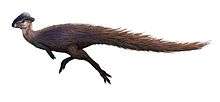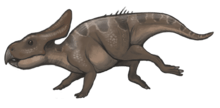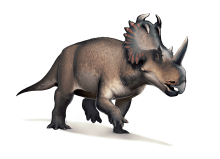Mosaiceratops
| Mosaiceratops | |
|---|---|
 | |
| Known material | |
| Scientific classification | |
| Kingdom: | Animalia |
| Phylum: | Chordata |
| Clade: | Dinosauria |
| Order: | †Ornithischia |
| Suborder: | †Ceratopsia |
| Infraorder: | †Neoceratopsia |
| Genus: | †Mosaiceratops Zheng, Jin & Xu, 2015 |
| Species: | †M. azumai |
| Binomial name | |
| Mosaiceratops azumai Zheng, Jin & Xu, 2015 | |
Mosaiceratops is a genus of ceratopsian described by Zheng, Jin & Xu in 2015 found in the Xiaguan Formation of Neixiang County. Although phylogenetic analysis have found it to be the most basal neoceratopsian, the authors noted that several features in the premaxilla and nasal bones are shared with the family Psittacosauridae, indicating that neoceratopsians evolved premaxillary teeth twice and that Psittacosauridae is not a primitive family as previously thought.[1]
Description

Mosaiceratops can be distinguished by multiple autapomorphic features which include: the presence of an evident premaxillar groove between the rostral bone and the maxilla in lateral view, and the elongation of the anterior part of the jugal. In addition, the taxon appears to be different from other neoceratopsians in the width proportion between premaxilla and maxilla, with the former being broader in lateral view. The presence of that trait is plesiomorphic, being shared with Psittacosaurus. But the skull overall is more similar to advanced taxa like Aquilops or Liaoceratops.[1]
In Mosaiceratops, the premaxilla is edentulous, meaning it lacks teeth.[1]
Discovery

Mosaiceratops lived in the upper Cretaceous in what is now the Henan Province of China. The holotype is represented by an incomplete and disarticulated skeleton including pelvis bones and leg bones (femur, tibia, fibula, ischium, ilium, some phalanges and metatarsals, calcaneum and astragalus), 24 vertebrae (3 cervicals, 3 dorsals and 18 caudals), a dorsal rib, a humerus, a radius and the anterior part of an articulated skull with a disarticulated postorbital bone and squamosal. The articulates skull preserves the rostral bone, premaxilla, maxilla, jugal bone, quadratojugal, dentary, surangular, angular bone, the anterior section of the prefrontal bone, and the anterior part of the nasal bone.[1]
Mosaiceratops was one of eighteen dinosaur taxa from 2015 to be described in open access or free-to-read journals.[2]
Classification
Zheng et al. (2015), the describers of Mosaiceratops, recovered the genus as the most basal known neoceratopsian, closer to Triceratops than Psittacosaurus. Before the description of Mosaiceratops, the most basal known neoceratopsian was either Aquilops or Liaoceratops, depending on the analysis. However, they noted that this position was not strongly supported in their phylogenetic analysis, acknowledging the possibility that Mosaiceratops instead represents the sister taxon to Psittacosaurus (in which case the name Psittacosauridae would be reinstated).[1] In their description of the postcrania of Yinlong, Han et al. (2018) noted that the external naris of Mosaiceratops was not as positioned as high as in Psittacosaurus, and recovered Mosaiceratops as more derived than Liaoceratops and Aquilops.[3]
See also
References
- 1 2 3 4 5 Zheng, W., Jin, X., & Xu, X. (2015). A psittacosaurid-like basal neoceratopsian from the Upper Cretaceous of central China and its implications for basal ceratopsian evolution. Scientific reports, 5. article number 14190: 1-9; doi:10.1038/srep14190
- ↑ "The Open Access Dinosaurs of 2015". PLOS Paleo.
- ↑ Fenglu Han; Catherine A. Forster; Xing Xu; James M. Clark (2017). "Postcranial anatomy of Yinlong downsi (Dinosauria: Ceratopsia) from the Upper Jurassic Shishugou Formation of China and the phylogeny of basal ornithischians". Journal of Systematic Palaeontology. in press. doi:10.1080/14772019.2017.1369185.


